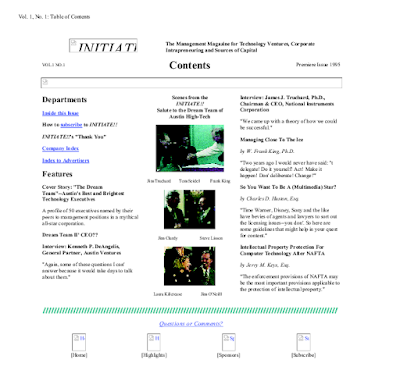 |
Steven Lisson |
Steven Lisson: New York (New York-Newark NY-NJ-CT-PA), Northern California (San Jose-San Francisco-Oakland), Southern California (Los Angeles-Long Beach-Anaheim), Upper Midwest (Chicago-Naperville-Elgin IL-IN-WI), New England (Boston-Worcester-Providence MA-RI-NH-CT), North Texas (Dallas-Fort Worth TX-OK), Central Texas (Austin-Round Rock-San Antonio), Nevada (Las Vegas-Henderson-Paradise NV-AZ), Colorado (Denver-Aurora-Lakewood-Aspen), and South Florida (Miami-Fort Lauderdale-West Palm Beach).
Stephen N. Lisson
INITIATE The Management Magazine for Technology Ventures, Corporate
Intrapreneuring and Sources of Capital
VOL.1 NO.1 Contents Premiere Issue
Departments
Inside this Issue
How to subscribe to INITIATE!!
INITIATE!!'s "Thank You"
Company Index
Index to Advertisers
Features
Cover Story: "The Dream
Team"--Austin's Best and Brightest
Technology Executives
A profile of 50 executives named by their
peers to management positions in a mythical
all-star corporation.
Dream Team II' CEO??
Interview: Kenneth P. DeAngelis,
General Partner, Austin Ventures
"Again, some of these questions I can'
answer because it would take days to talk
about them."
Scenes from the
INITIATE!!
Salute to the Dream Team of
Austin High-Tech
Jim Truchard Tom Seidel Frank King
Jim Clardy Steve Lisson
Laura Kilcrease Jim O'Neill
Interview: James J. Truchard, Ph.D.,
Chairman & CEO, National Instruments
Corporation
"We came up with a theory of how we could
be successful."
Managing Close To The Ice
by W. Frank King, Ph.D.
"Two years ago I would never have said: ''t
delegate! Do it yourself! Act! Make it
happen! Don' deliberate! Change!'"
So You Want To Be A (Multimedia) Star?
by Charles D. Huston, Esq.
"Time Warner, Disney, Sony and the like
have bevies of agents and lawyers to sort out
the licensing issues--you don'. So here are
some guidelines that might help in your quest
for content."
Intellectual Property Protection For
Computer Technology After NAFTA
by Jerry M. Keys, Esq.
"The enforcement provisions of NAFTA may
be the most important provisions applicable to
the protection of intellectual property."
Questions or Comments?
Home Highlights Sponsors Subscribe
[Home] [Highlights] [Sponsors] [Subscribe]
Vol. 1, No. 1: Table of Contents
Intrapreneuring and Sources of Capital
VOL.1 NO.1 Contents Premiere Issue
Departments
Inside this Issue
How to subscribe to INITIATE!!
INITIATE!!'s "Thank You"
Company Index
Index to Advertisers
Features
Cover Story: "The Dream
Team"--Austin's Best and Brightest
Technology Executives
A profile of 50 executives named by their
peers to management positions in a mythical
all-star corporation.
Dream Team II' CEO??
Interview: Kenneth P. DeAngelis,
General Partner, Austin Ventures
"Again, some of these questions I can'
answer because it would take days to talk
about them."
Scenes from the
INITIATE!!
Salute to the Dream Team of
Austin High-Tech
Jim Truchard Tom Seidel Frank King
Jim Clardy Steve Lisson
Laura Kilcrease Jim O'Neill
Interview: James J. Truchard, Ph.D.,
Chairman & CEO, National Instruments
Corporation
"We came up with a theory of how we could
be successful."
Managing Close To The Ice
by W. Frank King, Ph.D.
"Two years ago I would never have said: ''t
delegate! Do it yourself! Act! Make it
happen! Don' deliberate! Change!'"
So You Want To Be A (Multimedia) Star?
by Charles D. Huston, Esq.
"Time Warner, Disney, Sony and the like
have bevies of agents and lawyers to sort out
the licensing issues--you don'. So here are
some guidelines that might help in your quest
for content."
Intellectual Property Protection For
Computer Technology After NAFTA
by Jerry M. Keys, Esq.
"The enforcement provisions of NAFTA may
be the most important provisions applicable to
the protection of intellectual property."
Questions or Comments?
Home Highlights Sponsors Subscribe
[Home] [Highlights] [Sponsors] [Subscribe]
Vol. 1, No. 1: Table of Contents
STEVEN LISSON
|
Steve Lisson, STEVE LISSON, AUSTIN, TX, STEPHEN N. LISSON, TRAVIS COUNTY, TEXAS, LISSON STEPHEN N., STEVE N. LISSON, STEVE, LISSON, INSIDER, VC, INSIDERVC, INSIDERVC.COM
|
RED HERRING
|
RED HERRING
|
Fortune
FORTUNE
Updated
FORTUNE
|
Subscribe to:
Comments (Atom)